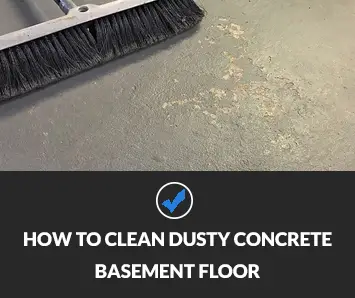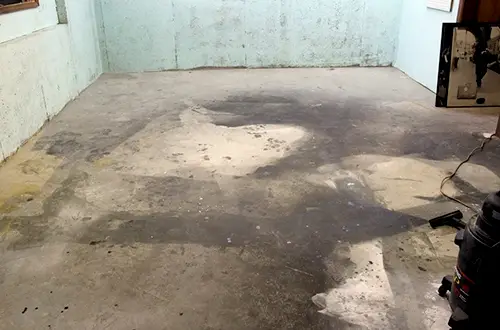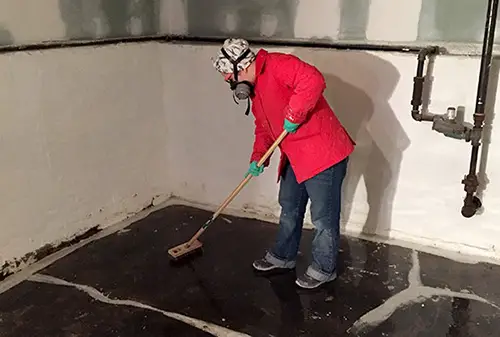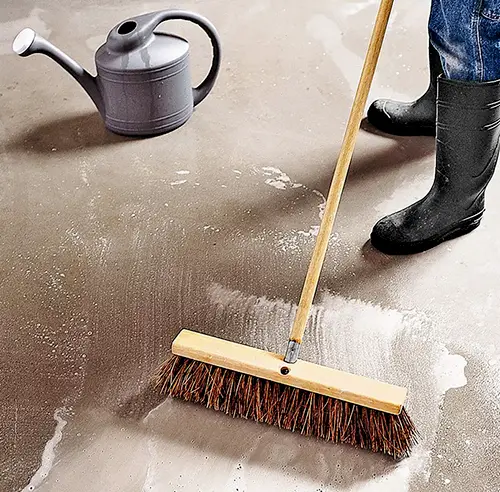Did you see our favorites?

Basements are another place in your house where you can relax, but many people avoid them because of filthy concrete floors and mildew smells. While carrying out home renovation tasks, consider cleaning the concrete floor of your basement. We’ll show you how to clean a concrete basement floor using a variety of floor cleaner techniques and cleaning suggestions.
Concrete is known for attracting stains like oil, rust, and dirt. While dehumidifiers can help prevent moisture accumulation, which might cause mold and mildew growth, these floors will still need to be cleaned on a regular basis.
Cleaning the basement floor with a degreaser or other efficient cleaning technique may go a long way toward removing stubborn stains and restoring the basement floor to its original state.


Dust can gather on garage floors since they are made of concrete. The major reason for dust is that garage floors are created of concrete. There are a variety of reasons why dirty concrete becomes such an issue, including:
During installation, these variables are all at play. The concrete will be in a constant state of disintegration as a result of such factors as foot traffic and automobiles rolling over it. This is why your dirty garage floor never seems to completely cleanse itself.

There are several alternatives. Bleach, ammonia (Note: never mix the two) and other commercial products can be used. Mix flour and hydrogen peroxide into a paste that’s similar in consistency to peanut butter to create a natural solution for persistent stains on interior concrete flooring. Apply the mixture over the stained area and leave it alone overnight. Then use a plastic-edged scraper tool to scrape off any residue.
Trisodium phosphate (TSP) combined with water and applied to the stained area with a nylon bristle brush can remove tough stains. Scrub until the dirt is gone, then rinse with a hose. TSP may be found at home improvement stores.
Muriatic acid may be used on outdoor surfaces to clean stubborn stains, such as rust or dried grout, and it is a strong, hazardous chemical that should be handled with care. When working with muriatic acid, use eye protection and gloves, and follow the manufacturer’s directions for cleaning concrete with muriatic acid usage.
For polished or stamped concrete floors, you’ll need to use a more gentle technique of cleaning. You’ll just utilize a sponge and a pail of water with a mild cleanser in it. Do not use ammonia, bleach, or any other highly acidic substance on polished or stamped surfaces. Castile soap, liquid dish detergent, stone cleaners, and mild floor cleaners are all good cleaners. Make a solution by combining the ingredients together and using a wet mop to apply it to the surface before rinsing the mop in clean water

There are many options for revitalizing the concrete basement flooring and making it look new and tidy once again. Those will fluctuate based on the objective of the cleaning, but regardless, a standard recipe is always available.
To clean a concrete floor in this method, you’ll need to set up all of the necessary equipment:

Cleaning your concrete basement floor not only removes stains and unpleasant odors, but it also creates an additional room in your house that has previously gone unnoticed. The recipes below will teach you how to restore that floor, whether it’s need a light cleaning or a deep clean.
Cleaning the floor is usually all that is required to eliminate basement odor that spreads throughout the area. Before you try any other techniques, clean the floor to remove unpleasant odors.
To remove the accumulation of daily dirt and debris from your concrete basement floor, complete a thorough cleaning of the basement floor before beginning wet cleaning.
To prepare a concrete floor for washing, clear everything from the basement floor, such as boxes, furniture, and other objects. To clean the dirt out of the floor and make it ready to be cleaned, use a vacuum cleaner or a push broom.
Begin at one end of the room and work your way to the other until all traces of dirt are gone. The basement floor is now ready for a damp cleaning.
This recipe demonstrates how to clean a concrete basement floor using trisodium phosphate, which is available at most home improvement stores. TSP is an inorganic alkaline chemical that is very soluble in water and functions well as a cleaning substance.
If you have a drain in your basement, use a hose to wet the concrete floor. To loosen dirt and grime, scrub the floor with a wire brush. Using the hose again, rinse the floor.
Pour the warm water and TSP into the pail and combine. After applying the solution to the stains, use the wire brush to scrub them away from the basement floor. Using a hose, rinse the floor clean.
TSP might also be useful for cleaning up when you remove old carpet from the basement floor. This combination includes carpet glue and cement. Apply it to the glue and allow it to sit for at least an hour. Scrape off the glue with a sharp tool and clean as usual.
You can clean stubborn stains on your cement using ammonia. Ammonia is a mild base that excels at breaking down grease and dirt.
Add some ventilation to the basement. Combine a quarter cup of ammonia, a few squirts of dish soap, and water in a pail. Wipe the solution over the concrete floor with a nylon scrub brush that has hard bristles.
Pour the cleaning solution directly over the floor stains if your basement has a built-in drain. Finally, rinse the floor with clean water to complete the process.
Discover the most basic technique for rust stains on concrete. Our rust stain remover is also wonderful since it does not require the use of cleaning solutions or liquids to remove rust from a concrete surface.
Sprinkle the scarred area with dry cement to eliminate the red rust. Rubbing a tiny amount of dry cement on a piece of flagstone is a good way to do it.
The stone and cement rubbing works in the same way as pumice to get rid of stains. Flagstone is commonly utilized as patio pavers and is readily available from any building supply store.
A buildup of moisture in the area causes mold and mildew. To prevent dampness in the basement, use a dehumidifier.
This basement floor cleaner works well for removing mildew and mold from concrete if you’ve already seen indication of fungus in the basement.
Make sure the area is well ventilated before you remove mold from the basement by opening a couple of windows or turning on a fan. If necessary, don’t forget to bring your old clothes and mask with you. In a spray bottle, combine 5 parts water and 1 part bleach. Spray the dirty areas of the floor to get rid of mold and mildew stains.
To remove mold, mildew, and grease stains, first clean the floor using a solution of 1 cup vinegar to 9 gallons water. Fill a spray bottle with the solution and use it to scrub the dirt off your floor. A stiff-bristled scrub brush is ideal for this. After you’ve cleaned your floor, use a mop and clean water to wipe away any residue.
The white deposit that appears on concrete surfaces is a soluble salt called efflorescence, which is caused by moisture seeping through the surface of concrete and then evaporating. Efflorescence build-up might be an indication that your basement walls need to be waterproofed.
The simplest approach to remove efflorescence from basement concrete is to use a coarse scrub brush. The white powder should be removed from the floor using a scrub brush. Then, using a wet sponge or mop, clean away the dust, making sure to squeeze out any extra water before wiping it away.
Chlorinated lime, commonly known as bleaching powder, is used to disinfect a concrete floor in this method. It’s available at any supermarket laundry aisle. Bleaching powder destroys noxious smells and germs from the concrete.
Make sure the entire surface of the concrete floor is covered with bleach powder and allowed to sit for a day to remove unpleasant scents. Sweep up all of the powder with a broom or vacuum, then dispose of it safely. If the stench persists even after cleaning, consider applying a concrete sealer to the floor.
This concrete stain remover doesn’t harm sealant or untreated concrete floors. The solution combines baking soda and dish soap to exfoliate stains and absorb smells.
To remove the stains, add a gallon of hot water to a large bucket and dissolve two tablespoons baking soda and a tablespoon dish soap. Scrub the cleaning solution over the filthy concrete with the scrub brush. After you’ve cleaned the floor, rinse it clean water. Towels should be used to dry off the floor.

Don’t be concerned, we have a few specialties for these situations as well!
If you come across any fungal fragments, consider using a DIY bleach solution to get rid of the unpleasant odor. Simply combine one quart of water and one or two ounces of common bleach in a blender and mix them in the tank.
Putting vinegar on the infected area with a rag, as advised by many cleaning professionals, may help. This approach will eliminate the noxious fungus, especially if you scrub it into the floor (and walls!) using a brush for improved effects. After you’ve finished, simply wipe away the remains with a damp mop.
If rust “invasion” occurs, first wet the damaged area and then apply a reasonable quantity of acetum or freshly-squeezed lemon juice to the rusted spots.
The product must remain in the rusted region for at least 20 minutes to be effective. You may only begin scrubbing the rusted areas of the concrete floor with a firm brush in circles and rinsing them with water once the product has stayed in the rusty zone for at least 20 minutes.
Another option for fading rust stains is to use a dry cement and a flagstone. Simply sprinkle some cement over the rust and rub it with a stone you’ll need to clean your basement floor.
If you have a layer of efflorescence on your cement flooring, cleaning it should be straightforward.
While efflorescence isn’t something unusual, it’s more frequent than you may think. When water seeps through concrete and evaporates, leaving that white powder behind, simply clean it with a firm brush and that’s all there is to it!
Whatever the reason may be, if you don’t want to do it alone or your basement is too big to deal with on your own, you can always hire local experts such as a house cleaning service in Sydney or some of your neighbors for cleaning out your concrete basement floor fast and fully.
After cleaning concrete floors, wipe them dry with a clean cloth to remove any soapy residue, and then allow them to completely dry.
Cleaning the concrete basement floor may appear to be more difficult than it appears at first. And owners of such floor coverings frequently repeat the same blunders that result in their floors being damaged and having to be replaced.
We propose that everyone consider the substantial restrictions surrounding basement concrete floor cleaning in order to avoid any unpleasant situations.
These few suggestions will keep your basement floor clean for a lot longer.
Did you see our favorites?
CleaningProductsLab.com is a participant in the Amazon.com Services LLC Associates Program. As an Amazon Associate we earn from qualifying purchases.
Amazon and the Amazon logo are trademarks of Amazon.com, Inc. or its affiliates.
The information on this blog is not meant as a substitute for medical advice, and should not be taken as such.